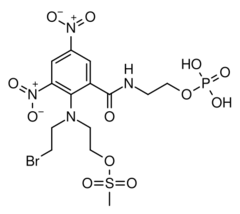Chemistry:PR-104
 | |
| Identifiers | |
|---|---|
| |
| CAS Number | |
| PubChem CID | |
| ChemSpider | |
| UNII | |
| Chemical and physical data | |
| Formula | C14H20BrN4O12PS |
| Molar mass | 579.27 g·mol−1 |
| 3D model (JSmol) | |
| |
| |
PR-104 is a drug from the class of hypoxia-activated prodrugs (HAPs),[1] which is being researched as a potential anti-cancer therapeutic agent. It is a phosphate ester “pre-prodrug” that is rapidly converted to the HAP PR-104A in the body. PR-104A is in turn metabolised to reactive nitrogen mustard DNA crosslinking agents in hypoxic tissues such as found in solid tumours.[2][3][4] Following initial clinical studies,[5][6] it was discovered that PR-104A is also activated by the enzyme AKR1C3, independently of hypoxia.[7] Hypoxia in the bone marrow of patients with leukaemia,[8][9] and high activity of AKR1C3 in some leukaemia subtypes [10][11][12] has led to interest in clinical trials of PR-104 in relapsed refractory acute leukaemias.[13][14]
References
- ↑ "Targeting hypoxia in cancer therapy". Nature Reviews. Cancer 11 (6): 393–410. June 2011. doi:10.1038/nrc3064. PMID 21606941.
- ↑ "Mechanism of action and preclinical antitumor activity of the novel hypoxia-activated DNA cross-linking agent PR-104". Clinical Cancer Research 13 (13): 3922–32. July 2007. doi:10.1158/1078-0432.CCR-07-0478. PMID 17606726. http://clincancerres.aacrjournals.org/content/13/13/3922.long.
- ↑ "DNA cross-links in human tumor cells exposed to the prodrug PR-104A: relationships to hypoxia, bioreductive metabolism, and cytotoxicity". Cancer Research 69 (9): 3884–91. May 2009. doi:10.1158/0008-5472.CAN-08-4023. PMID 19366798. http://cancerres.aacrjournals.org/content/69/9/3884.long.
- ↑ "Design of optimized hypoxia-activated prodrugs using pharmacokinetic/pharmacodynamic modeling". Frontiers in Oncology 3: 314. December 2013. doi:10.3389/fonc.2013.00314. PMID 24409417.
- ↑ "A phase I trial of PR-104, a nitrogen mustard prodrug activated by both hypoxia and aldo-keto reductase 1C3, in patients with solid tumors". Cancer Chemotherapy and Pharmacology 65 (4): 791–801. March 2010. doi:10.1007/s00280-009-1188-1. PMID 20012293.
- ↑ "A phase I trial of PR-104, a pre-prodrug of the bioreductive prodrug PR-104A, given weekly to solid tumour patients". BMC Cancer 11 (1): 432. October 2011. doi:10.1186/1471-2407-11-432. PMID 21982454.
- ↑ "The bioreductive prodrug PR-104A is activated under aerobic conditions by human aldo-keto reductase 1C3". Cancer Research 70 (4): 1573–84. February 2010. doi:10.1158/0008-5472.CAN-09-3237. PMID 20145130. http://cancerres.aacrjournals.org/content/70/4/1573.long.
- ↑ "Pronounced hypoxia in models of murine and human leukemia: high efficacy of hypoxia-activated prodrug PR-104". PLOS ONE 6 (8): e23108. 11 August 2011. doi:10.1371/journal.pone.0023108. PMID 21853076. Bibcode: 2011PLoSO...623108B.
- ↑ "Targeting hypoxia in the leukemia microenvironment". International Journal of Hematologic Oncology 2 (4): 279–288. August 2013. doi:10.2217/ijh.13.32. PMID 24490034.
- ↑ "A novel fluorometric assay for aldo-keto reductase 1C3 predicts metabolic activation of the nitrogen mustard prodrug PR-104A in human leukaemia cells". Biochemical Pharmacology 88 (1): 36–45. March 2014. doi:10.1016/j.bcp.2013.12.019. PMID 24434189.
- ↑ "AKR1C3 is a biomarker of sensitivity to PR-104 in preclinical models of T-cell acute lymphoblastic leukemia". Blood 126 (10): 1193–202. September 2015. doi:10.1182/blood-2014-12-618900. PMID 26116659.
- ↑ "Restoring Tumour Selectivity of the Bioreductive Prodrug PR-104 by Developing an Analogue Resistant to Aerobic Metabolism by Human Aldo-Keto Reductase 1C3". Pharmaceuticals 14 (12): 1231. November 2021. doi:10.3390/ph14121231. PMID 34959631.
- ↑ "Phase I/II study of the hypoxia-activated prodrug PR104 in refractory/relapsed acute myeloid leukemia and acute lymphoblastic leukemia". Haematologica 100 (7): 927–34. July 2015. doi:10.3324/haematol.2014.118455. PMID 25682597.
- ↑ "Targeting the hypoxic fraction of tumours using hypoxia-activated prodrugs". Cancer Chemotherapy and Pharmacology 77 (3): 441–57. March 2016. doi:10.1007/s00280-015-2920-7. PMID 26811177.
 |

